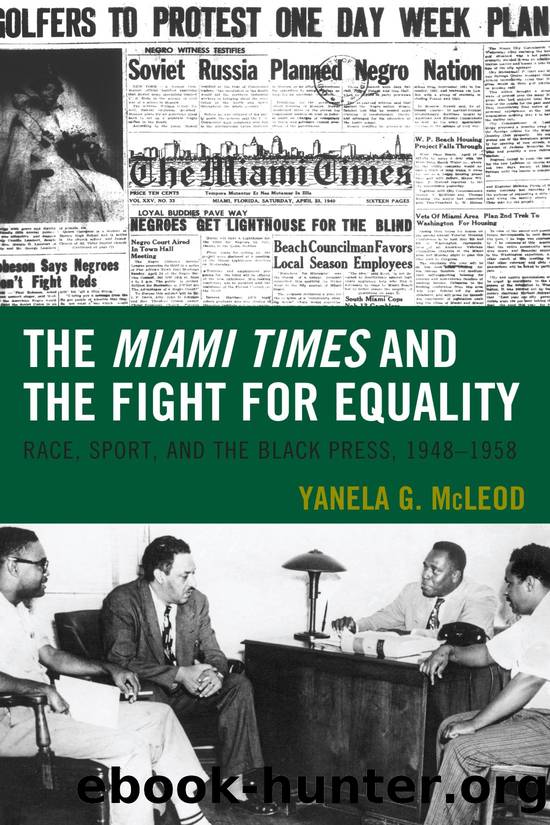The Miami Times and the Fight for Equality by McLeod Yanela G.;

Author:McLeod, Yanela G.;
Language: eng
Format: epub
Publisher: Lexington Books/Fortress Academic
Chapter 6
The Negro Golf Experience in the United States
Since its early 18th-century presence in the United States, black golfers have traveled several paths on their journey into the world of golf. Many, such as John Shippen, parlayed their roles as caddies on segregated courses into prestigious careers as professional and amateur golfers. Some, like Joseph M. Bartholomew, used their experience as groundskeepers and clubhouse staff as a springboard to become architects of golf courses and country clubs. Members of the black elite became involved with the game as associates of black golf clubs and social organizations. As accessibility to public and private links increased, so did the range of black economic classes that engaged in the sport. Distinguished black professionals such as doctors, lawyers, educators, and entrepreneurs played the greens, oftentimes in the same contingent with members of black labor classes including civil service employees, custodial workers, and domestic laborers. âGolf was one of the few black activities in which love of the sport transcended socioeconomic distinctions.â1
To accommodate the growing popularity of golf within their communities, African Americans established their own clubs and associations, designed racially inclusive golf courses, sponsored tournaments, and created a national golfing organizationâthe United States Colored Golf Association in 1925.2 The establishment of black-owned and operated golfing associations, courses, and clubhouses lends insight into how economic and social status impacted African Americansâ access to golf courses, athletic training, and tournament play.3 African Americans of economic means helped increase lower-economic populationâs awareness and access to the game through the establishment of golfing associations. Black women who created a national network of golf associations helped provide authentic opportunities for women to participate in competitive golf and served as vehicles to expose young girls to the game.4
Although sentiments of black elitism surfaced regarding use of resources to remove racial barriers in what some considered a sport that catered to an elect few instead of focusing energy on issues that impacted the black population as a whole, wealthy black professionals who were golfers emerged as leaders in the movement to eradicate segregation from all facets of their local communities.5 To the professional class, opposition to segregation within the realm of golf was not about catering to a small segment of privileged black society.6 It was indicative of the larger effort to tear down institutional racism that invaded every aspect of black life regardless of social or economic status.7
Operating within the boundaries of segregation, many black golfers tolerated the white-only prohibition as it related to private courses and clubs, but they repudiated the restrictive policies associated with publicly funded fairways.8 As taxpayers they felt they were entitled to use the course during its regularly scheduled hours of operation.9 Members of the black affluent class became a driving force behind the legal pursuits of black golfers.10 It was through local black golf associations that anti-discrimination lawsuits were filed, with many club members serving as plaintiffs. Wealthy black men and women also used their financial resources as well as their social and professional networks to cover legal expenses associated with the cases.
Download
This site does not store any files on its server. We only index and link to content provided by other sites. Please contact the content providers to delete copyright contents if any and email us, we'll remove relevant links or contents immediately.
The Vikings: Conquering England, France, and Ireland by Wernick Robert(79931)
Ali Pasha, Lion of Ioannina by Eugenia Russell & Eugenia Russell(40158)
The Conquerors (The Winning of America Series Book 3) by Eckert Allan W(37149)
The Vikings: Discoverers of a New World by Wernick Robert(36923)
Cecilia; Or, Memoirs of an Heiress — Volume 1 by Fanny Burney(32437)
Cecilia; Or, Memoirs of an Heiress — Volume 2 by Fanny Burney(31873)
Cecilia; Or, Memoirs of an Heiress — Volume 3 by Fanny Burney(31857)
Empire of the Sikhs by Patwant Singh(22978)
The Secret History by Donna Tartt(18852)
Hans Sturm: A Soldier's Odyssey on the Eastern Front by Gordon Williamson(18486)
Cat's cradle by Kurt Vonnegut(15189)
Pimp by Iceberg Slim(14398)
Sapiens: A Brief History of Humankind by Yuval Noah Harari(14254)
Talking to Strangers by Malcolm Gladwell(13229)
Norse Mythology by Gaiman Neil(13211)
Leonardo da Vinci by Walter Isaacson(13189)
4 3 2 1: A Novel by Paul Auster(12289)
Underground: A Human History of the Worlds Beneath Our Feet by Will Hunt(12027)
The Radium Girls by Kate Moore(11929)
